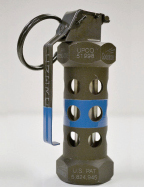A stun grenade, also known as a flash grenade, flashbang, thunderflash, or sound bomb,[1] is a non-lethal explosive device used to temporarily disorient an enemy's senses. Upon detonation, a stun grenade produces a blinding flash of light and an extremely loud "bang". They are often used in close-quarters combat, door breaching, and riot control, typically to stun enemies or distract them.[2]

Originally developed to simulate explosions during military training, stun grenades were first used by the British Army Special Air Service's counterterrorist wing in the late 1970s,[3][4] and have been used by police and military forces worldwide since.[5]
Despite their less-lethal nature, stun grenades are still capable of causing harm, and can injure or kill when detonating in close proximity. They are also capable of sparking fires.[6]
Effects
editStun grenades are designed to produce a blinding flash of light of around 7 megacandela (Mcd) and an intensely loud "bang" of greater than 170 decibels (dB).[7]
Construction
editUnlike a fragmentation grenade, stun grenades are constructed with a casing designed to remain intact during detonation and avoid fragmentation injuries, while having large circular cutouts to allow the light and sound of the explosion through. The filler comprises a pyrotechnic metal-oxidant mix of magnesium or aluminium and an oxidizer such as potassium perchlorate or potassium nitrate.[8]
Hazards
editWhile stun grenades are designed to limit injury, permanent hearing loss has been reported.[9][10] The concussive blast has the ability to cause injuries, and the heat generated may ignite flammable materials. The fires that occurred during the 1980 Iranian Embassy siege in London were caused by stun grenades.[11]
See also
edit- Blast ball – Less-lethal hand grenade
- Dazzler – Non-lethal temporary blindness weapon
- M84 stun grenade – American less-lethal pyrotechnic
- NICO BTV-1 flash-bang grenade – Flash-bang grenade used in the United States
References
edit- ^ "Drugs raid recovers tonnes of cocaine and marijuana in Chile". Daily Telegraph. London. September 3, 2014. Archived from the original on September 4, 2014.
- ^ "Joint Intermediate Force Capabilities Office > Current Intermediate Force Capabilities > M-84 Flash Bang Grenade". jnlwp.defense.gov. Archived from the original on September 29, 2020. Retrieved 2024-08-03.
- ^ "SAS - Weapons - Flash Bang | Stun Grenade". Elite UK Forces. Archived from the original on 2017-08-31. Retrieved 2013-05-29.
- ^ Bonneville, Leigh, The SAS 1983-2014 (Elite), Osprey Publishing, 2016, ISBN 1472814037 ISBN 978-1472814036, p.9
- ^ McEvoy, Matthew, et al. "State violence against protesters: Perspectives and trends in use of less lethal weapons." Torture Journal 34.1 (2024): 35.
- ^ Angwin, Julia; Nehring, Abbie. "Hotter Than Lava". ProPublica. Retrieved 2023-09-08.
- ^ "Measurement of Exposure to Impulsive Noise at Indoor and Outdoor Firing Ranges During Tactical Training Exercises" (PDF). Centers for Disease Control and Prevention. Archived (PDF) from the original on 2017-12-19. Retrieved 2013-08-25.
- ^ Tumbarska, Adelina (2018), "Non-Lethal Weapons in Domestic Law Enforcement: Some Legal and Ethical Aspects", 4th International Conference on Human Security, Belgrade: University of Belgrade, Faculty of Security Studies, Human Security Research Center, pp. 39–45, doi:10.18485/fb_ic4hs.2018.4, ISBN 978-86-80144-30-6, retrieved 2023-02-08
- ^ "Stun grenades cause permanent hearing loss". Kashmir Observer. Archived from the original on 2018-02-14.
- ^ Hambling, David (August 6, 2009). "Military Still Trying to Replace Dangerous Stun Grenades". Wired.
- ^ Perry, Mike (April 30, 2020). "40 years ago the British SAS stormed the Iranian Embassy and became world famous". The SOFREP Media Group. Retrieved June 12, 2023.
External links
edit- FM 3-23.30 Grenades and Pyrotechnic Signals. GlobalSecurity.org, 1 September 2000. Ch. 1, Sec. 10. "Stun Hand Grenades". Retrieved on 26 May 2011.